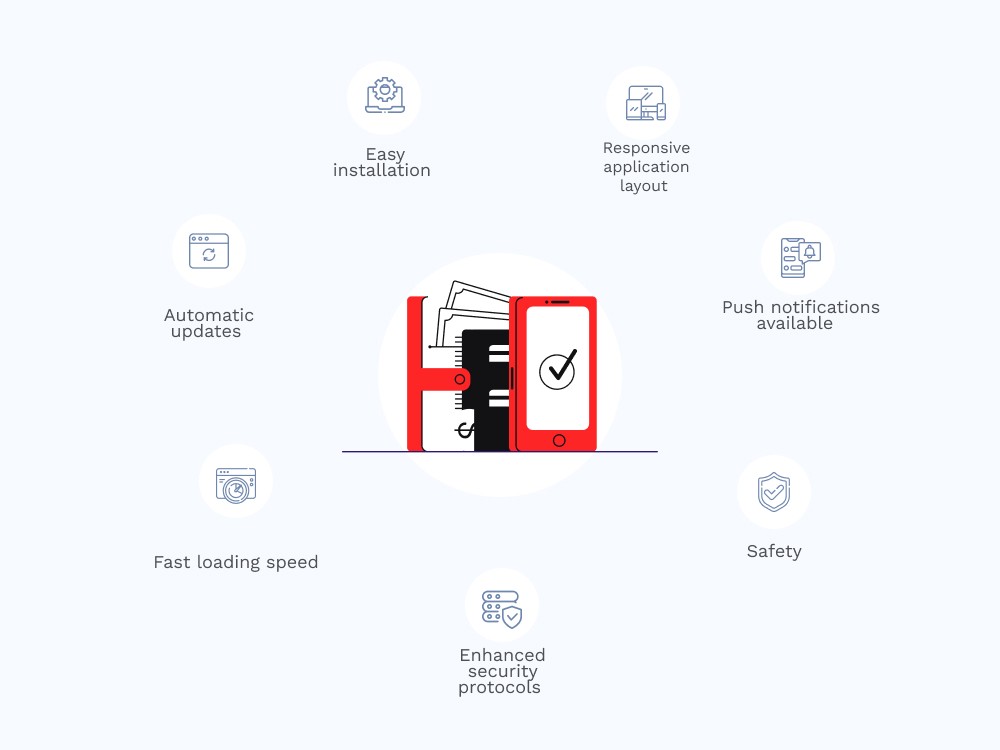The invention of smartphones ushered in the development of native apps to go with various devices. Since then, apps have changed the way people use the internet by providing a compact platform away from the browser.
However, companies today are reverting to browsers to address user demands. As a result, special apps that work on browsers became available for public use. These applications are called Progressive Web Apps (PWAs).
But why are progressive web apps relevant in tech today?
At first, companies like Twitter popularized the PWA market when implementing a progressive app for their platform. Today, companies like Spotify, Facebook, and Medium have a PWA platform and native apps.

Source: Smart Insights
Moreover, HTML5 adaptation for PWAs increases the functionality in contrast to native apps. Most web apps can function on any device with a browser, irrespective of the operating system.
According to a current survey, the rise in popularity of progressive apps coincides with the increase of smartphone users worldwide. And since 36% of internet users spend their time on smartphone browsers, a progressive web app increases conversion for your business.
So, let’s discuss the benefits and working principles of progressive web apps. You will also discover the best examples of PWA platforms for marketplaces.
What is a PWA or Progressive Web Application?
A Progressive Web Application (PWA) is software that works on a browser on both desktop and mobile devices. The core framework of progressive web apps features HTML5, CSS, JQuery, Javascript, and other programming languages.
Unlike native apps, PWAs are delivered through the web through smart web APIs and plugins. Native apps often require a software development kit (SDK), while PWAs need only a front-end framework and a browser.
Moreover, the front-end technologies required for PWA-development are more comfortable to master. In essence, progressive web applications are easier to build than native apps.
Although PWAs often have similar functionalities to native apps, they are more reliable and intuitive than native apps. Besides, they allow responsive full-screen modes, which is often problematic on mobile apps. As of 2019, PWAs work on all browsers, including Microsoft Edge.
Here are the main characteristics of any reliable progressive web app platform:
- Responsive application layout
- Hybrid appearance (browser+native app)
- Safety (served through HTTPS requests)
- Offline support
- Automatic updates
- Easy installation (if necessary)
- Progressive (works across multiple browsers)
- Fast loading speed (after initial startup)
- Enhanced security protocols
- Shareable via embedded links
- Push notifications available
- Full-screen user experience without the URLs

How do progressive web apps work?
Progressive web apps are software programs that provide an app-like experience on a browser.

Source: PWAStats
But before we dive deeper into the working principle of PWAs, let’s check out their four main components.
- Web Manifest — this is a JSON file that replicates the interface of a native application. This component controls visualization functions like full-screen mode. You can find icons, location, long and short URLs, and other metadata in the Web Manifest.
- Service worker — this component contains a script (Javascript file) that runs in the background, handling incoming and outgoing requests. This feature also controls push notifications and supports the offline mode synchronization of web apps. Service workers are event-specific with a short life span.
- Secure connection (HTTPS, not HTTP) — PWA requests can only be served over secure connections. Besides, PWAs rely on Transport Layer Security (TLS) for data exchange between two applications (devices). This function is a massive advantage for security in PWA usage.
- Application Shell — consists of a base user interface and other design elements for the app’s architecture. The app shell gives the PWA a definite structure by providing static and dynamic content.
So, when you open an app on a browser, the server receives an HTTPS request over a secure connection. The service worker processes this request and serves as an interface generated from the application shell. If no network is available, the service worker displays a cached version of the PWA. Simultaneously, the Web Manifest also displays icons and other metadata related to the progressive web app.
Moreover, it is essential to note that progressive web apps are independent of the App Store and Google Market. This uniqueness makes PWAs easy to update with permission from Apple and Google.
Benefits of using a progressive web application platform
PWAs are trending in the tech industry nowadays because of technical efficiency and financial advantages. The application provides hybrid solutions for users looking for native app alternatives.
Judging from our experience with progressive web apps examples, here are the benefits of PWAs:
- Progressive web apps are cheaper to build.
- They provide an enhanced user experience.
- They work online and offline.
- PWAs support push notifications, which increase user engagement.
- PWAs are discoverable in search results.
- They do not require massive code bases to develop.
- A progressive web application platform increases conversion.
- They are secure to use.
- PWAs allow automatic updates with permission from iOS and Android.

Five eCommerce Progressive Web Apps Examples 2021
Progressive web apps play a massive role in the overall performance of any business or company. Tech giants and multinational companies now deliver their services using a progressive app platform.

Source: Think With Google
Most of these companies build native apps and PWA for a marketplace. This means that the app’s features focus on improving the user experience.
To understand the relevance of PWAs today, let’s look at some great PWA examples available at the moment.
Alibaba
Alibaba is one of the largest eCommerce platforms in the world. At first, the company was skeptical about adopting PWA technology because users preferred shopping on the website rather than the app.

Source: Google for Developers
Eventually, Alibaba.com decided to build an app that combines the mobile app’s best qualities with the browser experience. This decision boosted their sales and engagement by 76%.
Also, the ‘Add to Home Screen’ feature experienced a significant increase in user interaction. As a result, Alibaba gained over 30% extra monthly users on Android alone. Today, this platform is one of the best PWA eCommerce examples out there.
Twitter is a world-renowned social media platform with a massive user pool of over 300 million worldwide. The majority of Twitter users visit the platform from their mobile devices, making the development of a progressive app a no-brainer.
In 2017, Twitter rolled out its version of a progressive web application called Twitter Lite. This application is one of the best examples of PWA platforms for social media companies.
Compared to the native Twitter app, the PWA uses less than 3% of the local storage while consuming less data than the app. Twitter Lite also works faster than the native app because of the online and offline capabilities.
Uber
Uber is one of the most famous taxi companies in the world. In the past, Uber users had to struggle with compatibility issues on the app. But since the Uber PWA came into existence, the user experience has improved significantly.
The Uber PWA interface closely replicates the original app experience but offers more functions than the native app.
Also, this progressive web app example works with very low internet connection speeds. You can book a ride over 2G networks. The core also occupies a memory capacity of around 50 KB, making it easier to find rides in extremely remote locations.
Debenhams
This British fashion brand is a staple of the fashion and beauty retail industry. Currently, they have stores in more than 25 countries.
Since the company relied so much on mobile traffic, they had to invest in a PWA to improve user experience.
According to the company’s Head of Operations, switching from native apps to progressive apps was inevitable for its growth. As a result, they created the perfect example of a progressive web application for fashion retailing.
As it stands, Debenhams’ PWA has increased the company’s revenue from mobile by 40% while conversions increased by 20%.
Forbes
Any news and entertainment company needs to expand its coverage and audience as wide as possible. As a global media company, Forbes attracts users to their website and app on a daily basis.
After launching their dedicated PWA in 2017, Forbes witnessed a massive increase in revenue and user engagement. Three years on, the company has already increased the engagement rate by twice the size.
Another fundamental change to the user experience is an expanded scroll depth, which is responsible for more completed articles.
Forbes’ progressive web application example is a game-changer for other companies operating in the news and entertainment sphere.
Ultimately, these companies mentioned above use the best PWA examples available in tech today. This PWA technology has played a significant role in their success. You can also check out other PWA site examples, like Flipboard and Pinterest.
Our Experience in Progressive Web App Development
As a tech partner, we provide top-notch software development services for mobile and progressive web applications. Our approach to solving problems relies on a systematic framework of step-by-step research and implementation of ideas.
One of our latest projects is a SaaS platform for real estate that allows users to work offline.
We organized a consultation session with the client to discuss the platform’s core features and business requirements. Then, our team of experts developed a roadmap over a 6-month period. The first version of the platform was released for use within the specified deadline.
However, while developing the platform, we found it challenging to properly analyze and interpret the real estate industry. And since the platform was meant to serve employers, tenants, and property owners, we had to develop an all-encompassing product.
To solve this problem, we evaluated the client’s business needs to develop a personalized PWA and Desktop Dashboard for users within the real estate system.
So, if you want to create a world-class progressive web application, contact our experts to start the process right away.
Final Thoughts
Progressive web apps are the current trend in software development. Big conglomerates and companies have started investing in building their progressive web applications. And judging from the increase in revenue, developing web apps for your business is a lucrative venture.
Progressive apps also improve user experience by improving efficiency and decreasing memory storage required to run the app. Moreover, these applications function with limited or on internet connection.
And in terms of revenue, PWAs are cheaper than native apps. They also cost a lot less to build, considering that they require less expertise to develop.
If you want to build a progressive app that will compete with the big companies in your industry, contact our team of developers at OSDB.io. We are industry leaders with a massive wealth of experience in software development.


